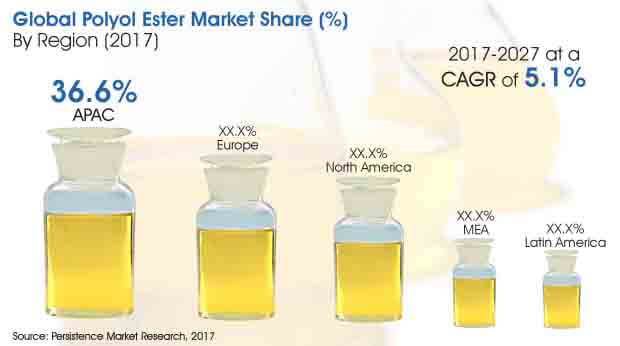Polyol Ester Market Segmented By NPG, TMP, PE, DiPE Product in Automotive Crankcase Material, Gear Oils, Fire Resistant Hydraulic Fluids, Carrier Fluids,Food Contact Material, Heat Transfer Fluids
Industry: Chemicals and Materials
Published Date: October-2017
Format: PPT*, PDF, EXCEL
Delivery Timelines: Contact Sales
Number of Pages: 396
Report ID: PMRREP18850
High maintenance cost
Ester lubricants such as phosphate esters, complex esters, and silicate esters deliver excellent lubricating and safety properties; however, various turbine such as Electro-Hydraulic-Control (EHC) users, and food processing equipment users struggle with the maintenance of ester lubricants. Ester lubricant maintenance require expensive tools and equipment. Outdated or incorrect EHC fluid maintenance equipment used in industrial and aviation applications, costs hundreds of millions of dollars, which restrains manufacturers of synthetic lubricants to produce ester lubricants in bulk.
Food grade lubricants conform to NSF International’s requirements of H-1 for finished lubricants and HX-1 for additives used in food grade and industrial application formulations. The HX-1 standard is not specific to any application, and hence, all lubricants designed for application -food grade or industrial - are included in the same category. These applications range from high viscosity gear oils to lower viscosity compressor oils. Also, the food grade lubricants industry is facing various restrictions on the amount of additives allowed to be used in combination with other chemistries.
Cheaper substitutes of friction modifier additives such as dispersant additives, detergent additives, extreme-pressure, oxidation and corrosion inhibitor anti-wear agents and oiliness agents are easily available for different lubricant applications.
Maintenance of laboratories with raw materials such as fatty acids, MoDTC, molebdenum disulphide, boron and other mechanical equipment used to test and evaluate friction modifier additives and lubricant performance require significant investment and are relatively costlier as compared to laboratories handling other types of raw materials. Also, decline in oil prices since second half of 2014, is anticipated to have a negative impact on prices of base oil and friction modifier additives.
Automotive applications account for around 75% of all lubricant additives sold in the U.S. Hence, lubricant additive manufacturers are closely tied to the future of automotive lubricants as compared to lubricant suppliers. The lubricants industry had registered a 30% decline in consumption in 2015, as a result of the use of fuel cells brought on by rapidly advancing fuel cell technology. This can be a major restraint to the friction modifier additives market, as engine oil accounts for approximately 85% of the lubricants currently used in automotive applications, and automobiles powered by fuel cells do not require engine oil.
The growing usage of Ashfree Neutralizing Molecules (ANM) as an alternative to calcium sulphur, or boron-based lubricant additives is inhibiting the demand for friction modifier additives in industrial and aviation applications. Due to their perfect solubility in all kinds of base oils, ANMs are stable and compatible when mixed with other cylinder lubricants.
ANMs react much faster with acids than conventionally used calcium carbonate or disulphides, and provide better fuel efficiency. They can match performance requirements of different fuels, including second-generation single-cylinder oils for engine and cylinder lubricants dedicated to dual fuel 2-stroke engines.

| Attribute | Details |
|---|---|
|
By Product |
|
| By Application |
|
| By Region |
|
| By End User |
|
To know more about delivery timeline for this report Contact Sales
